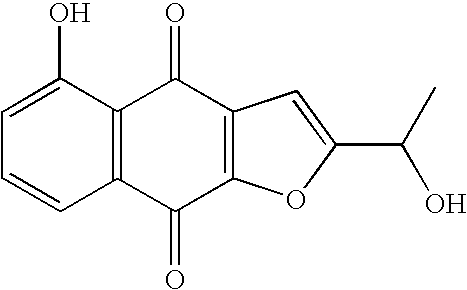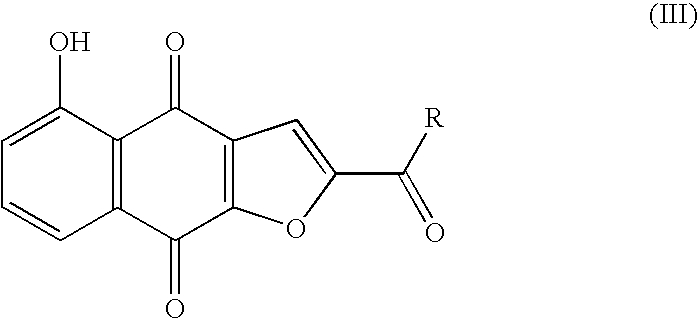Anticancer compound, intermediate therefor, and processes for producing these
a technology of anticancer compound and intermediate, which is applied in the field of anticancer compound, can solve the problems that dione has not been used in sufficient quantities, and achieve the effects of low cost, easy preparation of 2-, and low cos
- Summary
- Abstract
- Description
- Claims
- Application Information
AI Technical Summary
Benefits of technology
Problems solved by technology
Method used
Image
Examples
example 1
Preparation of 2-dimethylamino juglone
[0055]
[0056]To a solution of 5-hydroxynaphthalene-1,4-dione (also referred to as juglone) (171 mg, 1 mmol) in toluene (5 mL) is added dimethylamine (0.75 mL, 2.0M solution in THF, 1.5 mmol) at −20° C. The mixture is stirred at −20° C. for 1 hour, then thereto is added dimethylamine (0.75 mL, 2.0M solution in THF, 1.5 mmol), and the mixture is stirred at −20° C. for additional 30 minutes, then the solvent is evaporated in vacuo. The residue is purified by silica gel column chromatography (chloroform / ethyl acetate=20 / 1 (v / v)) to isolate 2-dimethylamino juglone (87.2 mg, 40%) and 3-dimethylamino juglone (28.8 mg, 13%).
2-Dimethylamino juglone
[0057]Melting point: 147 to 148° C.
[0058]1H-NMR (CDCl3): δ 3.25 (s, 6H), 5.72 (s, 1H), 7.20 (dd, 1H, J=1.2, 8.3 Hz), 7.45-7.51 (m, 2H), 13.0 (s, 1H).
3-Dimethylamino juglone
[0059]1H-NMR (CDCl3): δ 3.23 (s, 6H), 5.84 (s, 1H), 7.15 (dd, 1H, J=3.7, 6.1 Hz), 7.56-7.59 (m, 2H), 11.9 (s, 1H).
example 2
[0060]A reaction is carried out in the similar manner as described in Example 1, except substituting −40° C. for −20° C., to obtain 2-dimethylamino juglone (104 mg, 48%) and 3-dimethylamino juglone (20 mg, 10%).
example 3
[0061]A reaction is carried out in the similar manner as described in Example 1, except substituting water for THF for a solvent of dimethylamine, using 0.15 mL of an aqueous dimethylamine solution (50% aqueous solution, 1.5 mmol) and reacting at 0° C., to obtain 2-dimethylamino juglone (97 mg, 45%) and 3-dimethylamino juglone (67 mg, 31%). This method is more advantageous in environment and safety than the method of Example 1 in terms of substituting water for an organic solvent.
PUM
| Property | Measurement | Unit |
|---|---|---|
| w/w | aaaaa | aaaaa |
| boiling point | aaaaa | aaaaa |
| temperature | aaaaa | aaaaa |
Abstract
Description
Claims
Application Information
 Login to View More
Login to View More - R&D
- Intellectual Property
- Life Sciences
- Materials
- Tech Scout
- Unparalleled Data Quality
- Higher Quality Content
- 60% Fewer Hallucinations
Browse by: Latest US Patents, China's latest patents, Technical Efficacy Thesaurus, Application Domain, Technology Topic, Popular Technical Reports.
© 2025 PatSnap. All rights reserved.Legal|Privacy policy|Modern Slavery Act Transparency Statement|Sitemap|About US| Contact US: help@patsnap.com



